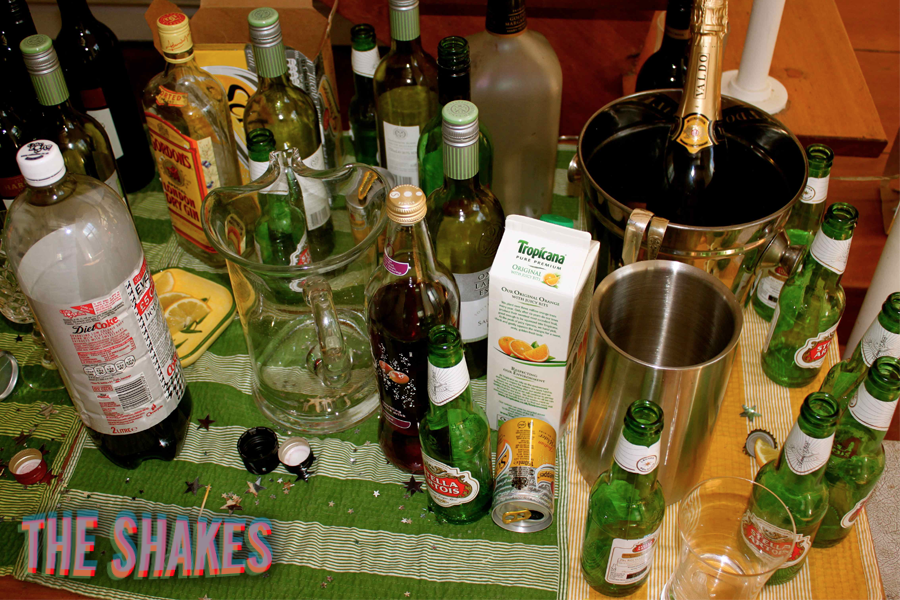It happens all the time: You throw a big party; buy all the booze you could possibly need; the evening is a wild success; everyone goes home happy (well, okay, somebody drunk-dials their ex and someone else throws up in an Uber, but almost everyone goes home happy); and you sleep soundly, satisfied that you can still get your friends and family properly drunk.
But now it’s the morning after, and while you’re not facing epic property damage, you do have a fairly big problem — THERE’S. SO. MUCH. LEFTOVER. BOOZE. Macrobrews. Microbrews. Red wine. White wine. Pink wine. Orange wine. Tequila. Vodka. Rum. Diet Coke. Seltzer water. Tonic water. Grenadine. Triple sec. Sweet vermouth. Bitters. Something green. Something blue.
What the hell are you supposed to do with it all?
I’m glad you asked…
So First: How Long Will It Last?
Toss any open beers you find. They’ll be warm, flat and possibly hosting a small family of fruit flies or the remnants of somebody’s cigarette. On the flip side, if it’s unopened liquor or wine, you can keep that shit for decades — if not longer. Corks have been used for centuries to let practically no air into a sealed bottle, thus preserving its contents.
While beer doesn’t have the benefit of a cork, it does have a healthy shelf-life if it’s unopened: So if you’ve got random six-packs leftover from New Year’s, they’re definitely still good. But if you’re looking at bottles of Bud you’ve had kicking around since last New Year’s, those should probably go.
Hard liquor, even opened, is perfectly fine for a few years.
Wine is a much different story.
“Every wine has a different turning point,” says Laura Burgess, a certified sommelier and well-known wine writer. “My general rule of thumb is a bottle of white wine half full or more lasts about four days, red wine half full or more about a week. The way to make sure it lasts is to stick the cork back in as far as it will go — so much so that you need to use a corkscrew again — and put it in the fridge.”
This goes for red and white wine: “Light, heat and oxygen deteriorate all things alcohol,” Burgess explains. “So you want to keep your open booze in a cool, dark place.”
As for bottles of wine that are less than half full…
…Cook With It
Wine, like vinegar (wine left open too long will eventually deteriorate into vinegar anyway), is fairly acidic and breaks down fibrous foods like kale and meats. “Alcohol is the perfect braising liquid because you have all of the same acids as you would have in vinegar but they’re not as concentrated, so you can use it more liberally,” says Burgess. “Those acids will break down chewy connective tissue or take the bitterness out of something like mustard greens.”
“I love to use things like onions and peppers as a sandwich topper,” she continues, “so I’ll use half bottles of white wine to simmer the vegetables for two or three hours. You get this really sweet spread, it’s partially pickled. I wouldn’t say it’ll keep forever, but it will last for like a month.”
You can cook with leftover beer, too. Beer bread has been around forever and uses a 12-ounce bottle of brew; dark beers, like Guinness, work well in glazes; mussels can be steamed in beer; and if you’ve ever spent a Thanksgiving in the Deep South, you’ve definitely roasted a turkey with a beer can in its ass.
Clean Your Cuts — and Apartment — With It
If I cut myself at work — there are lots of sharp objects behind the bar and sometimes I break things — and don’t have time to run to the office for an alcohol wipe (Band-Aids are always in a box in the kitchen), I’ll pour a splash of vodka on my wrist, finger or whatever appendage I’ve sliced open. “A flask of 80-proof is wildly useful, wherever you are,” Susan Casey writes in Outside. “It’s a disinfectant, an antimicrobial and an anesthetic, so it can clean a cut, prevent infection and de-stress the patient all at once.”
Casey’s list of vodka-treatable ailments include jellyfish stings, poison ivy, ear infections, fevers, sore throats and blisters.
You can clean your apartment with it, too. The alcohol content in any standard-proof vodka (80) is high enough to kill odor-causing bacteria. Gym bag reek? Spray it with some Svedka. Laundry really piling up? Mist it with Smirnoff. In fact, the only reason I have vodka in the house (it’s such a bore) is to clean my yoga mat.
Don’t, however, use anything other than vodka.
The barrel-aging of other spirits, like whiskey and rum, and the botanicals in gin add color and flavor, which is great for drinking but less so for sanitizing, particularly if you’re working with cheap booze. Seriously — the sugar and artificial coloring added to many cheap rums and whiskeys post-distillation will only turn your stinky things into sticky, stinky things.
Recycle It Into Something New
Infusions are the easiest thing in the world to make: Take a fruit, vegetable or herb whose flavor you’d like to experience in a cocktail, cut it up, put it in a large glass or plastic container and pour your leftover alcohol over it. Or if even that’s too complicated, stick your infusing ingredients directly into the leftover bottle of booze. (A quick tip on infusing: The higher the alcohol content of the liquor — i.e., the higher the proof — the faster it will infuse.)
After your potion has reached the desired flavor factor — check it a few times a day by tasting a tiny spoonful; infusing, like broiling meat, can go from perfect to wrecked quickly — buy yourself some mason jars and labels and gift with pride.
We had a cocktail at work that called for a jalapeño-infused Aperol, a 22-proof apertif. We made so many of the fuckers that we’d routinely run out of the “Japerol,” as we called it, because it had to infuse for at least three days.
The base of the cocktail, though, was Smith & Cross, a 114-proof Jamaican rum. Want to guess how long that takes to suck up the flavor of those sliced jalapenos?
Three hours.
We never bothered to infuse the Aperol again.
There are no hard-and-fast rules about which alcohols work best with which flavors. That’s all up to you. Some of my personal favorites, though, are stone-fruit infused tequilas (like peaches or plums) and herb-infused mezcal (we make a tarragon, thyme and rosemary mez that’s amazing). For whiskeys, I go to spices: Cinnamon (Fireball is a thing for a reason), chili and clove have all worked well for me. Vermouths infuse well, too. In fact Uncouth Vermouth does exactly that with all of its products, and they’re incredible.
While you can infuse gin, gin is already a spirit infused with botanicals. This doesn’t mean you shouldn’t do it, it just means you’re competing with a strong herbal backbone that may not stand down to whatever you decide to try.
And yes, fine, you can make strawberry vodka, or whatever, too.
Whatever You Do, Don’t Freeze It
Liquor can go in the freezer. (It doesn’t have to, but since, as Burgess says, light, oxygen and heat are what cause alcohol to degenerate, the freezer is a good place for it if you’ve got the room.) Be sure to keep everything else out of there, though. “Alcohol freezes at a different rate than water,” Burgess says. “When you freeze wine, the parts of wine that aren’t water get trapped in the middle, and it falls apart. The flavors and good acids start to separate out.”
Ever frozen a head of lettuce? It’s all good until it starts to thaw, then you have soggy, weird, gross lettuce. Wine works the same way. The different elements of the wine begin to separate themselves, and it just isn’t the same reconstituted.
And I don’t have to tell you what happens when you freeze beer, right?

